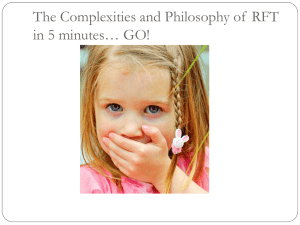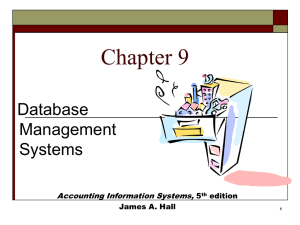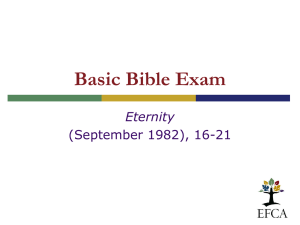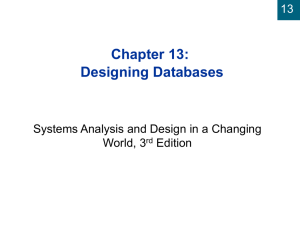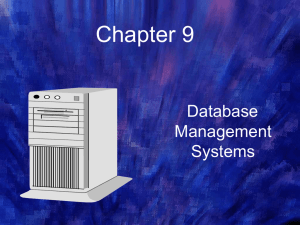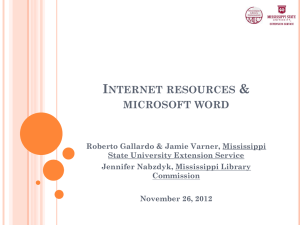immutability
advertisement
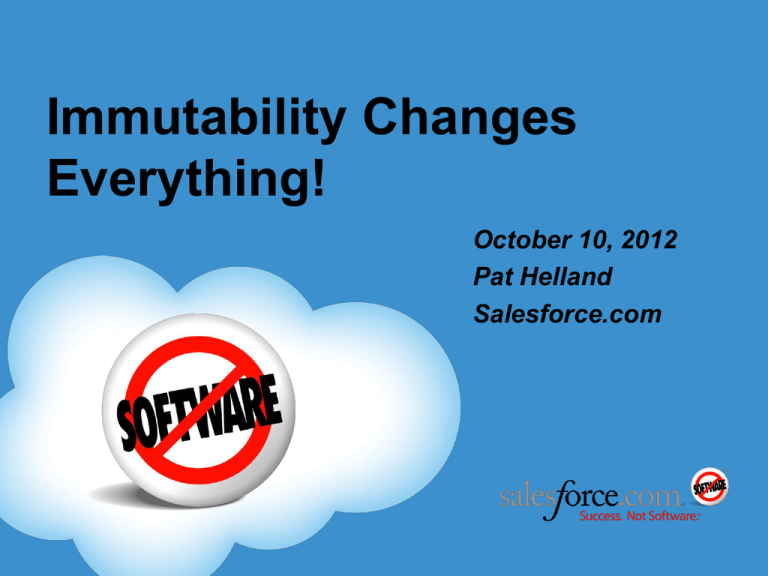
Immutability Changes Everything! October 10, 2012 Pat Helland Salesforce.com Outline Introduction Accountants Don’t Use Erasers Keeping the Stone Tablets Safe Hey! Versions Are Immutable, Too! Immutability by Reference Immutability Is in the Eye of the Beholder Normalization Is for Sissies Conclusion 2 Some Industry Trends to Consider Old New Computation (CPUS) Expensive Computation Cheap (Manycore Computers) Disk Storage Expensive Disk Storage Cheap (Cheap Commodity Disks) Coordination Easy (Latches Don’t Often Hit) Coordination Hard (Latches Stall a Lot, etc) DRAM Expensive DRAM / SSD Getting Cheap We Can Afford to Keep Immutable Copies of Lots of Data We Need Immutability to Coordinate with Fewer Challenges 3 Increasing Storage, Distribution, and Ambiguity Increasing Storage Cost per Gigabyte/Terabyte/Petabyte is dropping We can keep LOTS OF data for a LONG time This may be easing as we get faster and flatter networks in the datacenter Increasing Distribution More and more, we have data and work spread across a great distance Data within the Datacenter may be far away… Data within a many-core chip may be far away… Increasing Ambiguity Instruction opportunities lost waiting for a semaphore increase with more cores… When trying to coordinate with systems that are farther away, there’s more that’s happened since you’ve heard the news Can you take action with incomplete knowledge? Can you wait for enough knowledge? 4 Outline Introduction Accountants Don’t Use Erasers Keeping the Stone Tablets Safe Hey! Versions Are Immutable, Too! Immutability by Reference Immutability Is in the Eye of the Beholder Normalization Is for Sissies Conclusion 5 “Append-Only” Computing Many kinds of computing are “Append-Only” Observations are recorded forever (or a long time) Derived results are calculated on demand You can’t rewrite history Database transaction logs record all the changes made to the database High-speed appends to the log You never modify the log other than by appending to it The database is a cache of a subset of the log! The latest value of each record is kept in the database 6 Accounting: Recorded & Derived Knowledge Accountants don’t use erasers All entries in the ledger remain in the ledger Corrections can be made but only by new entries A company’s quarterly results are published o They include small corrections to the previous quarter… Small fixes are OK! Some entries describe observed facts We received these credits and debits Some entries are derived facts We amortized these capital expenses at this rate based on their cost and usage Your current balance depends on last months balance with applied debits & credits 7 The Append-Only View of Distributed Single-Master Computing Single-Master computing means somehow we order the changes Centralized Computing Two-Phase Commit or Paxos Optimistic Concurrency Control Somehow, we semantically apply one change at a time Each change is layered over its predecessors We can perceive a new set of values superseding the old ones This may be transactional or single-record changes but they appear in an order We continue to append new knowledge over the immutable history The new version of the truth is interpreted through the older versions 8 Distributed Computing “Back in the Day” Back before telephones, people used messengers Kids walking through town or riding bicycles to deliver the message The US Postal Service or the Pony Express would deliver the message Sometimes, people used fancy forms to capture the computing Add new data to a new part of the form Tear off the back copy of the form and file it Send the remaining portions to the next participant Each participant received the data they needed and added the new information to the form You cannot update earlier data on the form… o You can only append new knowledge to the form! Distributed computing was append-only! New messages, new additions to the forms… You couldn’t overwrite what had been written! Part 1 Part 1 Part 1 Part 1 Part 1Part 2 Part 2 Part 2 Part 2 Part 2Part 3 Part 3 Part 3 Part 3 … Part 3 … … … … 9 Outline Introduction Accountants Don’t Use Erasers Keeping the Stone Tablets Safe Hey! Versions Are Immutable, Too! Immutability by Reference Immutability Is in the Eye of the Beholder Normalization Is for Sissies Conclusion 10 Files, Blocks, & Replication for Durability & Availability GFS and HDFS (and others) offer highly-available files A file is a bunch of blocks (or chunks) The file (as a file name and description of needed blocks) is highly available Each block (chunk) is replicated within the cluster for durability and availability o Blocks are typically replicated three times with scrubbing o Replicas are placed across fault-zones Each file is immutable and (typically) single writer The file is created, one process can append to it, it lives for a while and is deleted Multi-writer files are hard (GFS had some challenges with failures and replicas) Immutable files and immutable blocks empower this replication The file system has no concept of a change to a complete file Each block’s immutability allows it to be replicated (and have extra replicas, too) High Availability of Immutable Blocks Is Affordable Now! Google, Amazon, Yahoo, Microsoft, and more keep Petabytes & Exabytes 11 Widely Sharing Immutable Files Is Easy Immutable files have an identity and a content Neither the identity nor the content can change You can copy the immutable file whenever and wherever you want Since you can’t change it, you don’t need to track where it’s landed! You can share the same immutable copy across users As long as you track reference counts (when it’s OK to delete it), you can use one copy of the file to share across many users You can distribute immutable files wherever you want Same identity, same contents, location independent! Published Books are Immutable! Sometimes later editions repair previous bugs This is versioning of the book Versions are immutable objects! 12 Names and Immutability… Watch Out for the Slippery Slope GFS (Google File System) and HDFS (Hadoop Distributed File System) provide immutable files Immutable blocks (chunks) are replicated across Data Nodes Immutable files are a sequence of blocks (chunks) The immutable files are identified with a GUID The contents of a file are immutable and labeled with a GUID The GUID will always refer to exactly that file and its contents GFS and HDFS also provide a namespace which can be changed The logical name of the immutable file may be changed to something else It takes care in usage to ensure that you have predictable results Is Something Really Immutable When Its Name Can Change? 13 Storing Immutable Data in an Eventually Consistent Store Consider a strongly consistent catalog Single master control over a namespace yielding GUIDs for the file blobs Now, keep the GUID to immutable blob storage in Dynamo or Riak The eventually consistent store will NEVER give you the wrong answer Each GUID will only yield one result because you never store different values RDBM S NameSpace Block & DataNode Mgmt Data Node Data Node Data Node … Data Node Data Nod e Data Nod e Data Nod e Data Nod e Data Nod e Riak Data Nod e Data Nod e Files/Blocks Identified by GUID Data Nod e Data Nod e Data Nod e Name Space NameNode File/Block Store HDFS Self-managing and master-less blob-store! 14 Outline Introduction Accountants Don’t Use Erasers Keeping the Stone Tablets Safe Hey! Versions Are Immutable, Too! Immutability by Reference Immutability Is in the Eye of the Beholder Normalization Is for Sissies Conclusion 15 Versions and History Linear Version History (a.k.a. Strongly Consistent): One version replaces another – One parent and one child in the sequence Each version is immutable Each version has an identity Typically, each new version is viewed as a replacement for the earlier one DAG (Directed Acyclic Graph) Version History (a.k.a. Eventual Consistency): Each version may have one or more parents Each parent may have one or more children Each parent may have children with different parents Each version is immutable Each version has an identity (but we may now need vector clocks to describe) Each version may be viewed as one of many replacement versions for its parents Versions Are Immutable and (Should) Have Immutable Names 16 Strongly Consistent Transactions Viewed as Versions In a Database, ACID transactions appear as if they have serial order This is called serializability I know there are reduced degrees of consistency but this is usually close to true Transaction T1 commits at one point and Transaction T2 at a later one Transaction T1 presents a consistent view of the entire database Transaction T2 presents a different and later view of the database An Active Database Is Constantly Presenting New Versions of Its Data Transaction T1 Is a Version of the Database Later, Transaction T2 Is a Version of the Database Everything Changeable Can Be Understood as a Bunch of Versions How Do You Identify the Versions? Can You See Old Ones? 17 BigTable & HBase: Interpreting the Immutable Entrails BigTable & HBase: Log: When a change occurs, write a record in the log to ensure its durable o Limited notion of transactions Major Compaction: an image (key sorted) of the key-value pairs at a point in time Minor Compaction: a set of new key-values (or new values for existing keys) o Represents changes to a set of keys since the last major compaction Both BigTable & HBase function by writing immutable files There is not an “update-in-place” to change the data There is an append to a new file (Minor Compaction) describing a new version Both BigTable & HBase provide a programmer perspective of versions Each key has a set of versions (in a linear, strongly-consistent sequence) A read may get the latest version or may get an earlier version Immutability Is at the Heart of BigTable & HBase Data Change Is By Appending to Files Which Become Immutable User Semantics Present Immutable Versions of Key-Values 18 Outline Introduction Accountants Don’t Use Erasers Keeping the Stone Tablets Safe Hey! Versions Are Immutable, Too! Immutability by Reference Immutability Is in the Eye of the Beholder Normalization Is for Sissies Conclusion 19 DataSets: Immutable Collections of Data A DataSet is a fixed collection of tables: The schema for each table is created when the DataSet is made The contents of each table is created when the DataSet is made A DataSet is immutable: o It is created, it may be consumed for reading, and it may be deleted … … Table1 Table2 DataSet-X … … TableN Schema DataSets may be relational or some other representation… 20 DataSets Referenced by a Relational Database DataSets can be present within the relational store The meta-data for the DataSet is visible within the relational database We may choose to store the DataSet “by-reference” but the contents are semantically present within the relational store Relational Database Stored Elsewhere… DataSet-X DataSet-Y … … Table1 Table2 DataSet-X … … TableN Schema DataSet-Z 21 Functional Calculations Outside a Relational DB Functional versus Dysfunctional calculations A functional calculation takes a set of inputs and predictably creates an output The entire calculation and pieces of it are idempotent o Idempotence: Doing it more than once is the same as doing it once! Idempotence: It’s Not That Hard! Work using DataSets can be performed outside the relational store The inputs may exist outside the relational store The computation may happen outside the relational store The results may be stored outside the relational store The results may appear (by reference) inside the relational store DataSet-M DataSet-N Functional Calculation DataSet-P DataSet-R DataSet-O 22 Relational Operations on Immutable DataSets You can meaningfully apply relational operations across locked relational data and immutable DataSets Relational operations are value based and require locking semantics Database concurrency control temporarily freezes the changing data Relational JOINS require frozen snapshots to be meaningful Locking presents a version of the Relational DB which can be joined Named and frozen DataSets may also be joined with the classic data Relational Database … Stored Elsewhere… Join TableA and Table1 TableA … … Table1 Table2 DataSet-X … … … TableN Schema DataSet-X TableB 23 Outline Introduction Accountants Don’t Use Erasers Keeping the Stone Tablets Safe Hey! Versions Are Immutable, Too! Immutability by Reference Immutability Is in the Eye of the Beholder Normalization Is for Sissies Conclusion 24 DataSets Are Semantically Immutable A DataSet is semantically immutable It has a set of tables, rows, and columns It may have semi-structured data (e.g. JSON) It may have app-defined data DataSets may be defined as a SELECTION, PROJECTION, or JOIN over previously existing DataSets Semantically, all that data is copied into a new DataSet Physically optimizations can occur … … Table1 Table2 DataSet-X … … TableN Schema 25 Optimizing DataSets for Read Patterns DataSets are semantically immutable but may be physically changed You can add an index or two You can denormalize tables to optimize for read access You can make a copy of a table with far fewer columns for fast access You can place partitions of the DataSet close to where they are being read You can dynamically watch the read usage of a DataSet and create optimizations for the new reader … … Table1 Table2 DataSet-X Inde x# 1 Inde x# 1 … … TableN Schema Denormalization of Parts of Table1 & Table 2 26 Immutability and “Big Data” Massively parallel computations usually are functional and based on immutable inputs MapReduce (Hadoop) and Dryad take immutable files as input The work is cut into pieces, each of which is immutable Functional computation (based on immutable inputs) is idempotent It’s OK to croak and restart Immutability Is the Backbone of “Big Data” Computations! Functional Computation with Immutable Inputs Failure and Restart Based on the Idempotent Nature of Functional Computing over Immutable Inputs 27 Immutability as a Semantic Prism DataSets show an immutable semantic perspective Even if the underlying representation is augmented or completely replaced The King James Bible is character for character immutable Even when printed in a different font… Even when digitized… Even when accompanied by different pictures… ???... Hmm… Is a DataSet changed if there is a loss-less transformation to a new schema representation The new address field has more capacity… Is that OK? The ENUM values are mapped to a new underlying representation… Is that OK? It’s Not Enough to Have the Right Bits! You Have to Know How to Interpret Them… “President Bush” meant a different thing in 1990 versus 2005 The word “Fanny” is interpreted differently in the US versus Australia You Need to know what the Immutable Bits Actually Mean! 28 Outline Introduction Accountants Don’t Use Erasers Keeping the Stone Tablets Safe Hey! Versions Are Immutable, Too! Immutability by Reference Immutability Is in the Eye of the Beholder Normalization Is for Sissies Conclusion 29 Why Normalize? Normalization’s goal is to eliminating update anomalies Can be changed without “funny behavior” Each data item lives in one place De-normalization is OK if you aren’t going to update! Emp # Emp Name 47 Joe 18 Sally 91 Pete 66 Mary Classic problem with de-normalization Emp Phone Mgr # Mgr Name Mgr Phone 5-1234 13 Sam 6-9876 3-3123 38 Harry 5-6782 2-1112 13 Sam 6-9876 5-7349 02 Betty 4-0101 Can’t update Sam’s phone # since there are many copies 30 We Are Swimming in a Sea of Immutable Data Data Owning Service Wednesday’s Price-List Wednesday’s Price-List Price-List Wednesday’s Price-List Tuesday’s Price-List Monday’s Price-List Wednesday’s Price-List Tuesday’s Price-List Listening Partner Service-1 Listening Partner Service-5 Listening Partner Service-8 Tuesday’s Price-List Monday’s Price-List Listening Partner Service-7 31 Think First Before You Normalize For God’s Sake, Don’t Normalize Immutable Data! Unless It’s to Optimize Space in the Representation… 32 Culture: the Way We Do Things Around Here People Normalize ‘Cuz their Professor Said To -- That’s Why We Need All Those Joins… If All You Have Is a Database, Everything Looks Like a Nail… 33 Outline Introduction Accountants Don’t Use Erasers Keeping the Stone Tablets Safe Hey! Versions Are Immutable, Too! Immutability by Reference Immutability Is in the Eye of the Beholder Normalization Is for Sissies Conclusion 34 Takeaways Things have changed towards immutability We need immutability to coordinate at ever increasing distances We can afford immutability because we have room to store versions for a long time Versioning allows a changing view of objects with immutable backing Linear (strongly consistent) version histories for some (e.g. BigTable, HBase) Directed-Acyclic-Graph (eventually consistent) history for others (e.g. Dynamo, Riak) Increasingly, systems are based on writing immutable data Log-Structured Merge trees (e.g. HBase, BigTable, LevelDB, etc.) as implementation Layering immutable data over a distributed file system offers robustness and scale Immutability extends consistent relational systems Very large immutable DataSets may be embedded by reference in relational stores The semantics of immutable DataSets joins cleanly with the changing relational data Semantically immutable data may be changed for optimization Projections, redundant copies, denormalization, column stores, indexing and more… Semantically immutable means the user behavior doesn’t change Immutability is the backbone of emerging “Big Data” systems MapReduce, Hadoop, and more leverage immutable snapshots 35 Immutability Changes Everything! 36

